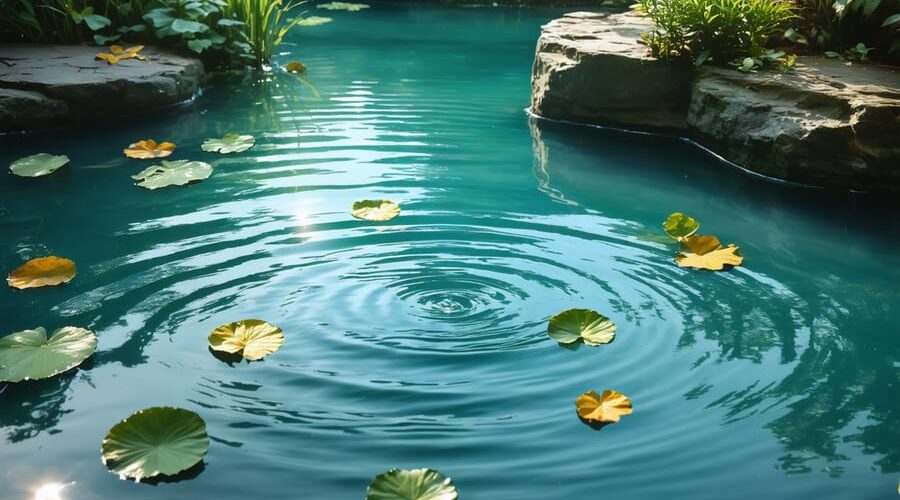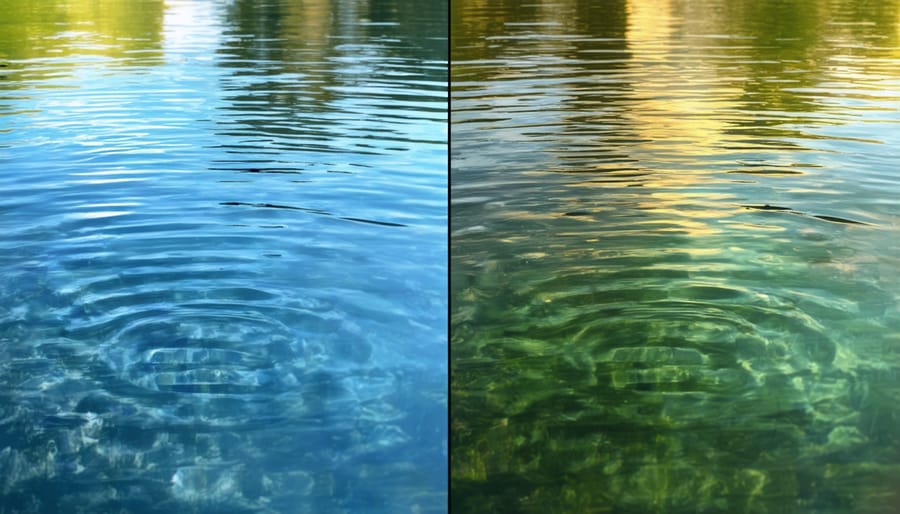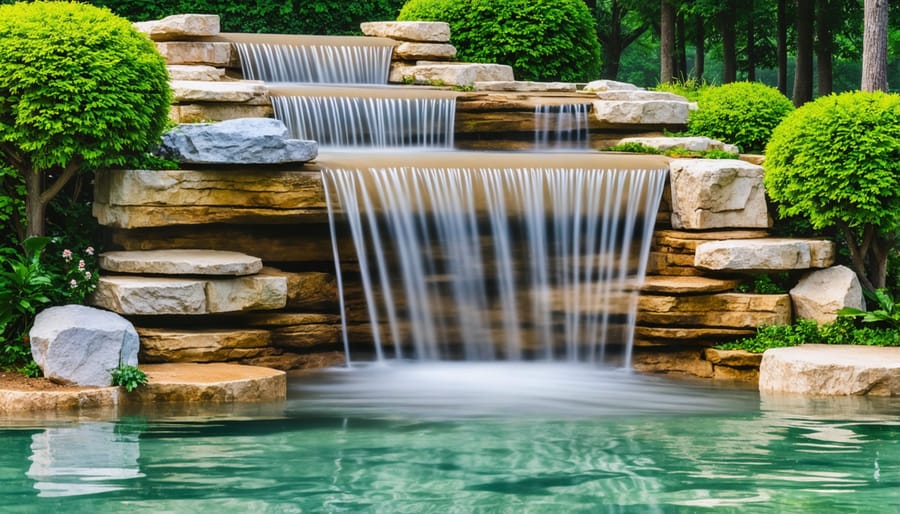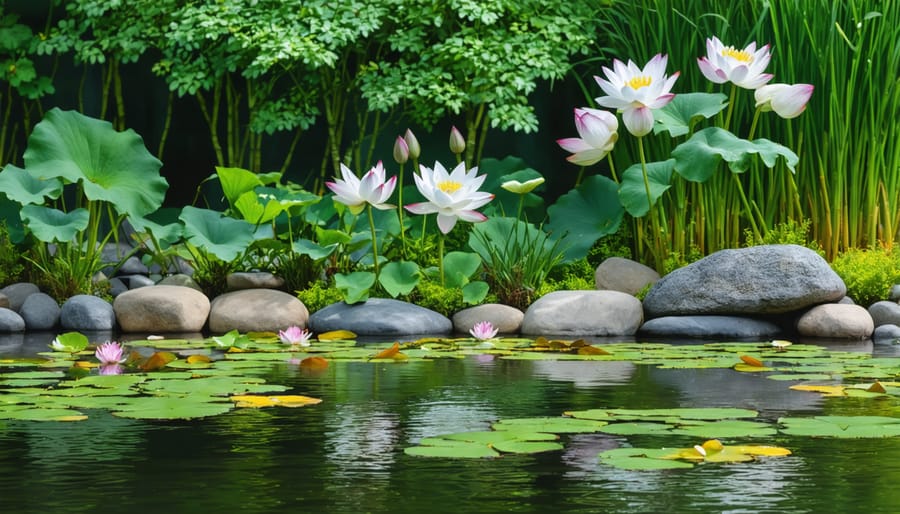
Transform Your Pond’s Visual Appeal with These Clever Water Texture Tricks
Transform your pond’s surface into a captivating visual masterpiece by understanding the intricate interplay of movement, light, and texture. Water texture in ponds creates that mesmerizing dance of ripples and reflections that turns an ordinary water feature into a dynamic focal point of your garden. Whether you’re designing a new pond or enhancing an existing one, mastering water texture techniques can dramatically elevate your outdoor space’s aesthetic appeal.
The secret to creating stunning pond water textures lies in the deliberate manipulation of water movement. From gentle ripples that catch morning light to more dramatic surface patterns that add depth and intrigue, each texture pattern serves a unique purpose in your pond’s overall design. Professional water gardeners have long understood that the right combination of circulation, fountain features, and strategic placement of water returns can transform a static pool into a living canvas of ever-changing patterns.
Let’s explore how to achieve these mesmerizing effects in your own backyard paradise…
Understanding Water Texture in Pond Design
Smooth vs. Rippled Surfaces
The interplay between smooth and rippled water surfaces creates dramatically different effects in your pond’s appearance. A smooth, glass-like surface acts like a mirror, perfectly reflecting the sky and surrounding landscape, creating a sense of depth and tranquility. This effect is particularly striking during sunrise and sunset when the water captures the changing colors of the sky.
Rippled surfaces, on the other hand, add dynamic movement and energy to your pond. These subtle waves catch and scatter light, creating sparkles and highlights that dance across the water. The gentle movement also helps prevent algae formation and deters mosquitoes from laying eggs, combining beauty with practical benefits.
The choice between smooth and rippled textures often depends on your garden’s style. Contemporary designs typically favor smooth surfaces for their minimalist appeal, while natural-style gardens benefit from gentle ripples that mimic wild water bodies. Many pond owners opt to incorporate both effects, using pumps or fountains that can be adjusted to create either texture based on mood or occasion.

Light and Reflection Effects
The interplay between light and water texture creates mesmerizing effects that can transform your pond’s appearance throughout the day. When sunlight hits rippling water, it creates dancing patterns called caustics that reflect onto nearby surfaces and underwater features. Smooth water acts like a mirror, perfectly reflecting the sky and surrounding landscape, while textured surfaces break up these reflections into sparkles and shimmers.
Morning and evening light are particularly magical times, as low-angle sunlight creates longer, more dramatic reflections across the water’s surface. Adding floating plants or decorative features can enhance these effects by creating additional texture points for light to play upon. Even on cloudy days, the subtle movements in your pond’s surface add depth and visual interest through gentle light diffusion.
Consider positioning seating areas where you can best appreciate these ever-changing light shows, especially during golden hour when the sun’s warm rays create the most stunning effects on your pond’s surface.
Creating Textural Contrasts
Water Movement Features
Adding dynamic water movement features to your pond can transform it from a still mirror into a captivating display of motion and sound. Fountains create elegant sprays that catch the light and add vertical interest, while waterfalls provide a dramatic cascade that naturally aerates the water. Bubblers offer a gentler option, creating subtle ripples that spread across the surface like rings on water.
When choosing your water feature, consider the size of your pond. A large fountain in a small pond can overwhelm the space, while a tiny bubbler might get lost in a larger body of water. For the best effect, try combining different features – perhaps a central fountain surrounded by smaller bubblers, or a waterfall that feeds into a series of gentle cascades.
The height and force of your water features also play a crucial role in texture creation. A higher fountain spray creates more dramatic patterns, while adjustable bubblers let you fine-tune the effect from a gentle simmer to a more vigorous boil. Remember that moving water also helps oxygenate your pond and prevent mosquito breeding, making these features both beautiful and practical.
To maximize impact, consider installing lighting near your water features. This will highlight the textural elements after dark and create stunning reflections that add another dimension to your pond’s appeal.

Strategic Placement
The placement of your water feature can dramatically influence how its texture appears and impacts your overall garden design. For maximum visual effect, consider positioning your pond where it can be viewed from multiple angles, particularly from frequently used spaces like patios or sitting areas. Natural light plays a crucial role in how water textures are perceived, so observe your garden throughout the day to identify spots where sunlight creates stunning reflections and shadows on the water’s surface.
When planning your pond’s location, think about viewing distances. Water textures are most impressive when they can be appreciated from both close-up and far-away vantage points. For example, placing a fountain or waterfall where it can be seen from inside your home through windows creates an engaging view that connects indoor and outdoor spaces.
Consider surrounding elements as well. Positioning your pond near plants that cast interesting shadows or reflect in the water can enhance its textural appeal. However, avoid placing water features directly under trees that shed heavily, as falling leaves can disturb the water’s surface and create maintenance challenges.
For the most dramatic impact, try creating different levels in your pond design. Step-downs, cascades, and varying depths add complexity to water movement and create more interesting textures. Remember that wind direction can affect water movement, so factor this into your placement strategy to ensure your water features perform as intended throughout the year.
Enhancing Texture with Natural Elements
Plant Selection and Placement
To enhance your pond with plants, consider both their visual impact and how they interact with water movement. Tall, graceful plants like cattails and rushes create gentle rippling effects when brushed by the wind, while floating plants like water lilies add surface texture through their broad leaves. Position taller plants along the back or sides of your pond where they won’t block the view but can still cast interesting shadows on the water.
For maximum impact, layer your plants at different heights. Place marginal plants like iris and marsh marigolds at the pond’s edge, then add submerged plants like hornwort in deeper areas. These not only create varied textures but also help maintain water quality. Floating plants should cover about 30-40% of your pond’s surface to achieve the right balance of open water and vegetation.
Remember to group similar plants together for visual impact, and leave enough space between clusters to allow for natural movement. This thoughtful arrangement will create dynamic water patterns while maintaining a natural, balanced appearance.

Surrounding Materials
The visual impact of your pond’s water texture can be dramatically enhanced by thoughtfully selecting and arranging surrounding materials. Natural stone and rocks create an organic transition between water and land, with larger boulders adding dramatic focal points and smaller river rocks softening edges. Consider using a mix of rounded and angular stones to create visual interest and contrast with the water’s movement.
Gravel pathways and beaches not only look attractive but also provide practical access points to your pond. Choose materials in earth tones that complement your local landscape – warm browns, grays, or sandy colors work well. For a more polished look, incorporate flat stepping stones or slate pieces along the pond’s edge.
Hardscaping elements like decorative walls, wooden decking, or concrete pavers can frame your pond beautifully while providing seating areas to enjoy the water display. These structured elements contrast nicely with the fluid nature of water, creating an engaging visual dynamic. Remember to leave some spaces between hard materials for aquatic plants, which soften edges and create a more natural appearance.
For the best effect, arrange materials in varying heights and depths, creating layers that draw the eye from the water’s surface to the surrounding landscape. This multi-level approach helps integrate your pond seamlessly into the overall garden design.
Maintenance Tips for Optimal Texture Effects
To keep your pond’s water texture effects looking their best, it’s essential to maintain water features regularly. Start by checking your pump and filtration system weekly for any debris or blockages that might affect water flow. Clean pump filters monthly, and remove any leaves or organic matter that could alter the water’s surface texture.
Keep an eye on water levels, especially during hot summer months when evaporation is high. Maintaining consistent water levels is crucial for achieving the desired texture effects, particularly with fountains and waterfalls. Top up as needed, but avoid doing so during peak sunlight hours to prevent temperature shock to aquatic life.
Monitor your pond’s edges and surrounding areas for plant overgrowth that might interfere with water movement. Trim back any overhanging vegetation that could drop leaves into the water and disrupt your carefully crafted surface patterns.
For the best results, test water quality monthly. Clear, healthy water creates more defined texture effects than cloudy or algae-filled water. Consider adding beneficial bacteria regularly to help break down organic matter and maintain water clarity.
During winter, protect your pumps and features from freezing. If you live in a cold climate, either run your water features continuously or store them properly for the season. This care will ensure your pond’s texture effects remain stunning year-round.
Creating the perfect pond water texture is both an art and a science that can transform your outdoor space into a captivating oasis. By implementing the techniques we’ve discussed – from strategic placement of fountains and waterfalls to choosing the right water movement features – you can achieve the exact water texture that suits your vision. Remember that maintenance is key to preserving your desired effect, so regular cleaning and adjustments will keep your pond looking its best. Whether you’re aiming for gentle ripples or dramatic cascades, the right water texture will enhance your pond’s visual appeal and create a more engaging garden environment. Start small, experiment with different features, and watch as your pond becomes a dynamic centerpiece that brings life and movement to your outdoor sanctuary.
